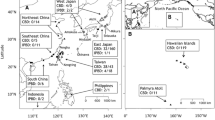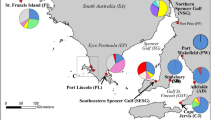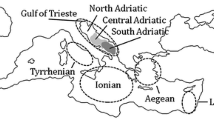Abstract
Patterns of dispersal and population structure of highly mobile marine fauna in the open ocean are not well understood. Much insight, however, can be gained from using common bottlenose dolphins (Tursiops truncatus), one of the most abundant marine mammals in the northern Gulf of Mexico (GOMx), as a model to better understand these aspects of the marine realm. Populations of common bottlenose dolphins in estuarine environments show evidence of strong population structure; however, whether this species similarly partitions the open ocean to the point that genetically differentiated populations are present is unknown. Such information is essential to accurately assess natural and anthropogenic impacts and is crucial for effective conservation and management. We used mitochondrial DNA control region sequence data, 19 microsatellite and 39 single nucleotide polymorphism loci to identify population structure of T. truncatus in coastal and offshore waters of the northern GOMx. Bayesian clustering and a multivariate method of discriminant analysis identified seven genetically distinct populations and levels of genetic differentiation were in line with other recognized populations of T. truncatus. The newly identified populations do not correspond to the currently delineated management stocks, suggesting revision may be necessary to establish accurate representation and effective management of the existing biological populations of T. truncatus in these waters. The finding of significant population structure in dolphins living in open-ocean waters augments the growing body of evidence indicating pelagic waters are not homogeneous even for highly mobile species.




Similar content being viewed by others
References
Allendorf FW, Luikart G (2007) Conservation and the genetics of populations. Blackwell Publishing, Malden
Andrés AM, Clark AG, Shimmin L et al (2007) Understanding the accuracy of statistical haplotype inference with sequence data of known phase. Genet Epidemiol 31:659–671
Baird RW, Gorgone AM, McSweeny DJ, Ligon AD, Deakos MH, Webster DL, Schorr GS, Martien KK, Salden DR, Mahaffy SB (2009) Population structure of island-associated dolphins: evidence from photo-identification of common bottlenose dolphins (Tursiops truncatus) in the main Hawaiian Islands. Mar Mammal Sci 25:251–274
Balkenhol N, Holbrook JD, Onorato D, Zager P, White C, Waits LP (2014) A multi-method approach for analyzing hierarchical genetic structures: a case study with cougars Puma concolor. Ecography 37:001–012
Bandelt HJ, Forster P, Röhl A (1999) Median-joining networks for inferring intraspecific phylogenies. Mol Biol Evol 16:37–48
Banguera-Hinestroza E, Evans PGH, Mirimin L, Reid RJ, Mikkelsen B, Couperus AS, Deaville R, Rogan E, Hoelzel AR (2014) Phylogeography and population dynamics of the white-sided dolphin (Lagenorhynchus acutus) in the North Atlantic. Conserv Genet 15:789–802
Barros NB, Ostrom PH, Stricker CA, Wells RS (2010) Stable isotopes differentiate bottlenose dolphins off west-central Florida. Mar Mammal Sci 26:324–336
Beerli P (1998) Estimation of migration rates and population sizes in geographically structured populations. In: Carvalho G (ed) Advances in molecular ecology, NATO-ASI workshop series. IOS Press, Amsterdam, pp 39–53
Beerli P (2004) Effect of unsampled populations on the estimation of population sizes and migration rates between sampled populations. Mol Ecol 13:827–836
Beerli P (2009) How to use MIGRATE or why are Markov chain Monte Carlo programs difficult to use? In: Bertorelle G, Bruford MW, Hauffe HC, Rizzoli A, Vernesi C (eds) Population genetics for animal conservation, vol 17. Conservation biology. Cambridge University Press, Cambridge, pp 47–79
Beerli P, Felsenstein J (1999) Maximum-likelihood estimation of migrate rates and effective population numbers in two populations using a coalescent approach. Genetics 152:763–773
Beerli P, Felsenstein J (2001) Maximum-likelihood estimation of a migration matrix and effective population sizes in n subpopulations by using a coalescent approach. Proc Natl Acad Sci USA 98:4563–4568
Brookes AJ (1999) The essence of SNPs. Gene 234:177–186
Brooks RA, Bell SS, Purdy CN, Sulak KJ (2004) The benthic community of offshore sand banks: a literature synopsis of the benthic fauna resources in potential MMS OCS sand mining areas. Tech. Rep. CEC NEGOM Program Investigation Report No. 2004-01, USGS Outer Continental Shelf Studies Ecosystem Program Report, Minerals Management Service
Browning SR, Browning BL (2011) Haplotype phasing: existing methods and new developments. Nat Rev Genet 12:703–714
Brownstein MJ, Carpten JD, Smith JR (1996) Modulation of non-templated nucleotide addition by Taq DNA polymerase: primer modifications that facilitate genotyping. Biotechniques 20:1004–1010
Brumfield RT, Beerli P, Nickerson DA, Edwards SV (2003) The utility of single nucleotide polymorphisms in inferences of population history. Trends Ecol Evol 18:249–256
Chilvers BL, Corkeron PJ (2001) Trawling and bottlenose dolphins’ social structure. Proc R Soc Lond B 268:1901–1905
Coulon A, Fitzpatrick W, Bowman R, Stith BM, Makarewich A, Stenzler LM, Lovette IJ (2008) Congruent population structure inferred from dispersal behavior and intensive genetic surveys of the threatened Florida scrub-jay (Aphelocoma coerulescens). Mol Ecol 17:1685–1701
Darriba D, Taboada GL, Doallo R, Posada D (2012) jModelTest 2: more models, new heuristics and parallel computing. Nat Methods 9:772
Development Core Team R (2014) R: a language and environment for statistical computing. R Foundation for Statistical Computing, Vienna
Duffield DA, Ridgway SH, Cornell LH (1983) Hematology distinguishes coastal and offshore forms of dolphins (Tursiops). Can J Zool 61:930–933
Escorza-Treviño S, Archer FI, Rosales M, Lang A, Dizon AE (2005) Genetic differentiation and intraspecific structure of Eastern Tropical Pacific spotted dolphins, Stenella attenuata, revealed by DNA analyses. Conserv Genet 6:587–600
Evanno G, Regnaut S, Goudet J (2005) Detecting the number of clusters of individuals using the software STRUCTURE: a simulation study. Mol Ecol 14:2611–2620
Excoffier L, Lischer HEL (2010) Arlequin suite ver 3.5: a new series of programs to perform population genetics analyses under Linux and Windows. Mol Ecol Resour 10:564–567
Excoffier L, Smouse PE, Quattro M (1992) Analysis of molecular variance inferred from metric distances among DNA haplotypes: application to human mitochondrial DNA restriction data. Genetics 131:479–491
Excoffier L, Hofer T, Fool M (2009) Detecting loci under selection in a hierarchically structured population. Heredity 103:285–298
Fernández R, Begoña Santos M, Pierce GJ et al (2011) Fine-scale genetic structure of bottlenose dolphins, Tursiops truncatus, in Atlantic coastal waters of the Iberian Peninsula. Hydrobiologia 670:111–125
Fernández R, Schubert M, Vargas-Velázquez AM et al (2015) A genomewide catalogue of single nucleotide polymorphisms in white-beaked and Atlantic white-sided dolphins. Mol Ecol Resour 16:266–276
Foll M, Gaggiotti OE (2008) A genome scan method to identify selected loci appropriate for both dominant and codominant markers: a Bayesian perspective. Genetics 180:977–993
Futuyma DJ (1986) Evolutionary biology, 2nd edn. Sinauer Associates, Sunderland
Gorgone A, Haase P, Griffith E, Hohn A (2008) Modeling response of target and nontarget dolphins to biopsy darting. J Wildlife Manage 72:926–932
Goudet J (1995) FSTAT (version 1.2): a computer program to calculate F-statistics. J Hered 86:485–486
Guindon S, Gascuel O (2003) A simple, fast, and accurate algorithm to estimate large phylogenies by maximum likelihood. Syst Biol 52:696–704
Haasl RJ, Payseur BA (2011) Multi-locus inference of population structure: a comparison between single nucleotide polymorphisms and microsatellites. Heredity 106:158–171
Heylar SJ, Hemmer-Hansen J, Bekkevold D et al (2011) Application of SNPs for population genetics of nonmodel organisms: new opportunities and challenges. Mol Ecol Resour 11:123–136
Hoelzel AR, Dahlheim M, Stern SJ (1998) Low genetic variation among killer whales (Orcinus orca) in the eastern North Pacific and genetic differentiation between foraging specialists. J Hered 89:121–128
Holm S (1979) A simple sequentially rejective multiple test procedure. Scand J Stat 6:65–70
Huelsenbeck JP, Ronquist F (2001) MRBAYES: Bayesian inference of phylogenetic trees. Bioinformatics 17:754–755
Jombart T (2008) adegenet: a R package for the multivariate analysis of genetic markers. Bioinformatics 24:1403–1405
Jombart T, Devillard S, Balloux F (2010) Discriminant analysis of principal components: a new method for the analysis of genetically structure populations. BMC Genet 11:94
Kalinowski ST, Wagner AP, Taper ML (2006) ML-RELATE: a computer program for maximum likelihood estimation of relatedness and relationship. Mol Ecol Notes 6:576–579
Kingston SE, Rosel PE (2004) Genetic differentiation among recently diverged delphinid taxa determined using AFLP markers. J Hered 95:1–10
Kingston SE, Adams LD, Rosel PE (2009) Testing mitochondrial sequences and anonymous nuclear markers for phylogeny reconstruction in a rapidly radiating group: molecular systematics of the Delphininae (Cetacea: Odontoceti: Delphinidae). BMC Evol Biol 9:245
Krützen M, Valsecchi E, Connor RC, Sherwin WB (2001) Characterization of microsatellite loci in Tursiops aduncus. Mol Ecol Notes 1:170–172
Krützen M, Sherwin WB, Berrgren P, Gales N (2004) Population structure in an inshore cetacean revealed by microsatellite and mtDNA analysis: bottlenose dolphins (Tursiops sp.) in Shark Bay, Western Australia. Mar Mammal Sci 20:28–47
Liu N, Chen L, Wang S, Oh C, Zhao H (2005) Comparison of single-nucleotide polymorphisms and microsatellites in inference of population structure. BMC Genet 6(Suppl 1):S26
Maddison WP, Maddison DR (1992) MacClade: analysis of phylogeny and character evolution, version 3. Sinauer Associates, Sunderland
Martien KK, Baird RW, Hedrick NM, Gorgone AM, Thieleking JL, McSweeny DJ, Robertson KM, Webster DL (2011) Population structure of island-associated dolphins: evidence from mitochondrial and microsatellite markers for common bottlenose dolphins (Tursiops truncatus) around the main Hawaiian Islands. Mar Mammal Sci 28:E208–E232
McClure MR, Greenbaum IR (1999) Allozymic variation and biogeography of snapping shrimp (Alpheus) from the Gulf of Mexico and northwestern Atlantic coasts. Southwest Nat 44:462–469
McClure MR, McEachran JD (1992) Hybridization between Prionotus alatus and P. paralatus in the northern Gulf of Mexico (Pisces: Triglidae). Copeia 1992:1039–1046
Mead JG, Potter CW (1995) Recognizing two populations of bottlenose dolphin (Tursiops truncatus) off the Atlantic coast of North America: morphologic and ecologic considerations. IBI Reports 5:31–44
Meirmans PG, Van Tienderen PH (2004) GENOTYPE and GENODIVE: two programs for the analysis of genetic diversity of asexual organisms. Mol Ecol Notes 4:792–794
Mendez M, Rosenbaum HC, Subramaniam A, Yackulic C, Bornino P (2010) Isolation by environmental distance in mobile marine species: molecular ecology of franciscana dolphins at their southern range. Mol Ecol 19:2212–2228
Mesnick S, Taylor BL, Archer FI et al (2011) Sperm whale population structure in the eastern and central North Pacific inferred by the use of single-nucleotide polymorphisms, microsatellites and mitochondrial DNA. Mol Ecol Resour 11:278–298
Mirimin L, Westgate A, Rogan E, Rosel P, Read A, Coughlan J, Cross T (2009) Population structure of short-beaked common dolphins (Delphinus delphis) in the North Atlantic Ocean as revealed by mitochondrial and nuclear genetic markers. Mar Biol 156:821–834
Montagu G (1821) Description of a species of Delphinus, which appears to be new. Mem Wernerian Nat Hist Soc 3:75–82
Morin PA, Luikart G, Wayne RK, the SNP workshop group (2004) SNPs in ecology, evolution and conservation. Trends Ecol Evol 19:208–216
Morin PA, Martien KK, Taylor BL (2009) Assessing statistical power of SNPs for population structure and conservation studies. Mol Ecol Resour 9:66–73
Morin PA, Archer FI, Pease VL et al (2012) Empirical comparison of single nucleotide polymorphisms and microsatellites for population and demographic analyses of bowhead whales. Endanger Species Res 19:129–147
Narum SR, Banks M, Beacham TD et al (2008) Differentiating salmon populations at broad and fine geographical scales with microsatellites and single nucleotide polymorphisms. Mol Ecol 17:3464–3477
Natoli A, Birkun A, Aquilar A, Lopez A, Hoelzel AR (2005) Habitat structure and the dispersal of male and female bottlenose dolphins (Tursiops truncatus). Proc R Soc Lond B 272:1217–1226
NMFS, National Marine Fisheries Service (2005) Revisions to Guidelines for Assessing Marine Mammal Stocks. http://www.nmfs.noaa.gov/pr/pdfs/sars/gamms2005.pdf. Accessed 11 Jan 2017
Park SDE (2001) Trypanotolerance in West African Cattle and the population genetic effects of selection. Dissertation, University of Dublin
Peakall R, Smouse PE (2006) GenAlEx 6: genetic analysis in Excel. Population genetic software for teaching and research. Mol Ecol Notes 6:288–295
Portnoy DS, Gold JR (2012) Evidence of multiple vicariance in a marine suture-zone in the Gulf of Mexico. J Biogeogr 39:1499–1507
Pritchard JK, Stephens M, Donnelly P (2000) Inference of population structure using multilocus genotype data. Genetics 155:945–959
Quérouil S, Freitas L, Cascão I et al (2010) Molecular insight into the population structure of common and spotted dolphins inhabiting the pelagic waters of the Northeast Atlantic. Mar Biol 157:2567–2580
Raymond M, Rousset F (1995) GENEPOP (version 1.2): population genetics software for exact tests and ecumenicism. J Hered 86:248–249
Rooney AP, Merritt DB, Derr JN (1999) Microsatellite diversity in captive bottlenose dolphins (Tursiops truncatus). J Hered 90:228–231
Rosel PE (2003) PCR-based sex determination in Odontocete cetaceans. Conserv Genet 4:647–649
Rosel PE, Block BA (1996) Mitochondrial control region variability and global population structure in the swordfish, Xiphias gladius. Mar Biol 125:11–22
Rosel PE, Dizon AE, Heyning JE (1994) Genetic analysis of sympatric morphotypes of common dolphins (genus Delphinus). Mar Biol 119:159–167
Rosel PE, France SC, Wang JY, Kocher TD (1999a) Genetic structure of harbour porpoise, Phocoena phocoena, populations in the Northwest Atlantic based on mitochondrial and nuclear markers. Mol Ecol 8:S41–S54
Rosel PE, Tiedemann R, Walton M (1999b) Genetic evidence for limited trans-Atlantic movements of the harbor porpoise Phocoena phocoena. Mar Biol 133:583–591
Rosel PE, Forgetta V, Dewar K (2005) Isolation and characterization of twelve polymorphic microsatellite markers in bottlenose dolphins (Tursiops truncatus). Mol Ecol Notes 5:830–833
Rosel PE, Hansen L, Hohn AA (2009) Restricted dispersal in a continuously distributed marine species: common bottlenose dolphins Tursiops truncatus in coastal waters of the western North Atlantic. Mol Ecol 18:5030–5045
Rousset F (2008) GENEPOP’007: a complete reimplementation of the Genepop software for Windows and Linux. Mol Ecol Resour 8:103–106
Ryynänen HJ, Tonteri A, Vasemägi A, Primmer CR (2007) A comparison of biallelic markers and microsatellites for the estimation of population and conservation genetic parameters in Atlantic salmon (Salmo salar). J Hered 7:692–704
Scheet P, Stephens M (2006) A fast and flexible statistical model for large-scale population genotype data: applications to inferring missing genotypes and haplotypic phase. Am J Hum Genet 78:629–644
Schroeder WW, Wood CR (2000) Physical/biological oceanographic integration workshop for De Soto Canyon and adjacent shelf: October 19–21, 1999. OCS Study MMS 2000-074. U.S. Department of the Interior, Minerals Management Service, Gulf of Mexico OCS Region, New Orleans, LA, pp 168
Sellas AB, Wells RS, Rosel PE (2005) Mitochondrial and nuclear DNA analyses reveal fine scale geographic structure in bottlenose dolphins (Tursiops truncatus) in the Gulf of Mexico. Conserv Genet 6:715–728
Stephens M, Scheet P (2005) Accounting for decay of linkage disequilibrium in haplotype inference and missing-data imputation. Am J Hum Genet 76:449–462
Stephens M, Smith NJ, Donnelly P (2001) A new statistical method for haplotype reconstruction from population data. Am J Hum Genet 68:978–989
Tamura K, Nei M (1993) Estimation of the number of nucleotide substitutions in the control region of mitochondrial DNA in humans and chimpanzees. Mol Biol Evol 10:512–526
Taylor B (1997) Defining “population” to meet management objectives for marine mammals. In: Dizon AE, Chivers SJ, Perrin WF (eds) Molecular genetics of marine mammals, Society of Marine Mammalogy, Special Publication 3. Lawrence, KS, pp 49–65
Taylor BL, Chivers SJ, Larese J, Perrin WF (2007) Generation length and percent mature estimates for IUCN assessments of cetaceans. Administrative Report LJ-07-01, Southwest Fisheries Science Center, National Marine Fisheries Service, NOAA, pp 21
Valsecchi E, Amos W (1996) Microsatellite markers for the study of cetacean populations. Mol Ecol 2:377–379
Van Oosterhout C, Hutchinson WF, Wills DPM, Shipley P (2004) MICRO-CHECKER: software for identifying and correcting genotyping errors in microsatellite data. Mol Ecol Notes 4:535–538
Vignal A, Milan D, SanCristobal M, Eggen A (2002) A review on SNP and other types of molecular markers and their use in animal genetics. Genet Sel Evol 34:275–305
Viricel A, Rosel PE (2014) Hierarchical population structure and habitat differences in a highly mobile marine species: the Atlantic spotted dolphin. Mol Ecol 23:5018–5035
Vollmer NL (2011) Population structure of common bottlenose dolphins in coastal and offshore waters of the Gulf of Mexico revealed by genetic and environmental analyses. Dissertation, University of Louisiana at Lafayette
Vollmer NL, Rosel PE (2012) Developing genomic resources for the common bottlenose dolphin (Tursiops truncatus): isolation and characterization of 153 single nucleotide polymorphisms and 53 genotyping assays. Mol Ecol Resour 12:1124–1132
Vollmer NL, Rosel PE (2013) A review of common bottlenose dolphins (Tursiops truncatus truncatus) in the northern Gulf of Mexico: population biology, potential threats, and management. Southeast Nat 12((Monograph 6)):1–43
Vollmer NL, Viricel A, Wilcox L, Moore MK, Rosel PE (2011) The occurrence of mtDNA heteroplasmy in multiple cetacean species. Curr Genet 57:115–131
Waring GT, Josephson E, Maze-Foley K, Rosel PE, eds (2015) U.S. Atlantic and Gulf of Mexico marine mammal stock assessments-2014. NOAA Technical Memorandum NMFS-NE-231, pp 361
Whitlock MC, McCauley DE (1999) Indirect measures of gene flow and migration: F ST ≠ 1/(4Nm + 1). Heredity 82:117–125
Wright S (1965) The interpretation of population structure by F-statistics with special regard to systems of mating. Evolution 19:395–420
Acknowledgements
We sincerely thank all who collected and donated samples for this project including A. Martinez, J. Wicker (NMFS Miami, FL), W. McFee (NOS Charleston, SC), B. Griffin (Mote Marine Lab), L. Klatsky (Dolphin Quest Inc.), R. Wells (Chicago Zoological Society/Mote Marine Lab), K. Barry, W. Hoggard, K. Mullin, C. Sinclair (NMFS Pascagoula, MS) and H. Whitehead (TMMSN), and all who responded to the 2007 and 2008 mortality events in Texas and Louisiana. We would also like to thank P. Beerli (MIGRATE) and M. Stephens (PHASE) for analytical and programming help. We are especially grateful to the past and present lab mates including R. Cota, A. Sellas, A. Viricel, D. Weisbaum and L. Wilcox. The University of Louisiana at Lafayette Graduate Student Organization and Sigma-Xi Grants-in-Aid of Research provided funding toward this project. All or portions of the laboratory and/or computer work were conducted in and with the support of the L.A.B. facilities of the National Museum of Natural History or its partner laboratories. Biopsy effort was conducted under NMFS MMPA permits 779-1339-00, 779-1633-00 and 775-1600-10.
Author information
Authors and Affiliations
Corresponding author
Ethics declarations
Conflict of interest
All authors declare that they have no conflict of interest and all applicable international, national and/or institutional guidelines for the care and use of animals were followed.
Additional information
Responsible Editor: O. Puebla.
Reviewed by undisclosed experts.
Electronic supplementary material
Below is the link to the electronic supplementary material.
Rights and permissions
About this article
Cite this article
Vollmer, N.L., Rosel, P.E. Fine-scale population structure of common bottlenose dolphins (Tursiops truncatus) in offshore and coastal waters of the US Gulf of Mexico. Mar Biol 164, 160 (2017). https://doi.org/10.1007/s00227-017-3186-x
Received:
Accepted:
Published:
DOI: https://doi.org/10.1007/s00227-017-3186-x




